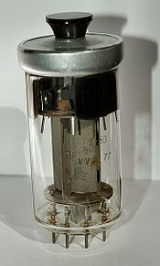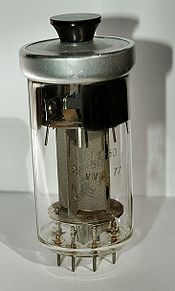
GU-50
Encyclopedia

Pentode
A pentode is an electronic device having five active electrodes. The term most commonly applies to a three-grid vacuum tube , which was invented by the Dutchman Bernhard D.H. Tellegen in 1926...
vacuum tube
Vacuum tube
In electronics, a vacuum tube, electron tube , or thermionic valve , reduced to simply "tube" or "valve" in everyday parlance, is a device that relies on the flow of electric current through a vacuum...
intended for 50 Watt operation as a linear RF
Radio frequency
Radio frequency is a rate of oscillation in the range of about 3 kHz to 300 GHz, which corresponds to the frequency of radio waves, and the alternating currents which carry radio signals...
amplifier on frequencies up to 120 MHz. It is in fact a Soviet-produced copy of the Telefunken
Telefunken
Telefunken is a German radio and television apparatus company, founded in Berlin in 1903, as a joint venture of Siemens & Halske and the Allgemeine Elektricitäts-Gesellschaft...
LS-50 power pentode, possibly reverse-engineered from German (Wehrmacht
Wehrmacht
The Wehrmacht – from , to defend and , the might/power) were the unified armed forces of Nazi Germany from 1935 to 1945. It consisted of the Heer , the Kriegsmarine and the Luftwaffe .-Origin and use of the term:...
) military radios captured during World War II
World War II
World War II, or the Second World War , was a global conflict lasting from 1939 to 1945, involving most of the world's nations—including all of the great powers—eventually forming two opposing military alliances: the Allies and the Axis...
, or based on documentation captured as a trophy. It is one of the more unusual types of tube because of its non-standard 8-pin base and a metal "cap" (not connected to any of the tube internal elements) with a plastic "handle" on top of the envelope - which is meant to ease extracting the tube from its socket (especially when the tube is hot). One of stock Russian-produced socket includes a rugged die-cast metal cage-like enclosure for the tube with spring-loaded locking lid. (The cap was made for fixation of the tube in the metal can, since tubes were designed for mobile operations). Another stock Russian-produced socket is stamped of light aluminium sheet metal, without a lid on top.
In the past the tube was very popular with Soviet and Eastern European amateur radio
Amateur radio
Amateur radio is the use of designated radio frequency spectrum for purposes of private recreation, non-commercial exchange of messages, wireless experimentation, self-training, and emergency communication...
operators because it was commonly available (from military and government warehouses) and could produce fairly large amounts of output power using relatively simple designs. Also, it was popular in Soviet era DIY audio amplifiers for hi-fi and musical instruments. GU-50 tubes were used also in first TV sets as a horizontal sweep output stage, and in medical devices as RF generators. The tube was never used in mass production amplifiers for civil usage because of relatively expensive technology and materials used.
Although the tube was not originally designed for the purpose, recently some valve sound enthusiasts have used the GU-50 in hi-fi tube audio, both in Single-Ended Triode
Single-ended triode
A single-ended triode vacuum tube electronic amplifier uses a single triode to produce an output, in contrast to a push-pull amplifier which uses a pair of devices with antiphase inputs to generate an output with the wanted signals added and the distortion components subtracted...
and Push-pull amplifier designs.
During the Soviet years the tube was produced by one of the major Soviet transmitting-tube manufacturers in the city of Ulianovsk. At this time it is unclear if current production of the tube exists; however, large quantities of New Old Stock (NOS) GU-50s appear to be available in the former Soviet Union and Eastern Europe and the type is far more readily found than the original LS-50.
GU-50 was not alone There were another successors of designed by Telefunken LS-50. Switzerland's BBC produced P50/1 and later modified version P50/2. They had the same base and pinout like original LS-50. German Democratic Republic made P50 that had the same bulb like Soviet ГУ-50. Later RFT made P50-1 version of their tube. Unlike Soviet TV designers that used stock military GU-50 for first TV sets, Eastern German manufacturers offered P50-2 especially made for TV horizontal sweep duties.
There were also versions with simplified bulbs made for civil usage, but internals were still too expensive to compete against civil tubes like rugged clones of RCA 6L6 and especially designed later sweep tubes like EL500. Western Germany version was called EL152, Eastern Germany version was called SRS552N.
The tube, despite of its European popularity, was not well known in U.S.A. and Canada, until audiophiles rediscovered it after collapse of Eastern political block and Soviet Union.
The Chinese version of this Tube is called FU-50 and production still continues. Probably by Shuguang, the major Chinese tube builder.
External links
- http://wavebourn.com/pyramid-8/GU-50.jpg - GU-50 curves from Radio #9 1961 magazine.
- http://www.radiomuseum.org/tubes/tube_gu-50.html - GU-50 at radiomuseum.org.
- http://www.radiomuseum.org/tubes/tube_ls50.html - LS-50 at radiomuseum.org.
- http://www.wiwitubes.com/pic/tube/TFKel152.jpg EL-152 tube (modified LS-50)
- http://i003.radikal.ru/0801/10/282eb0bda9a7.jpg Original LS-50
- http://www.icver.com/images/PIC/F/FU/FU-50.jpg Picture of recent FU50 (china)
- http://wavebourn.com/forum/download.php?id=123&f=7 - a prototype of High-end stereo amplifier using GU-50 output tubes
- http://www.jogis-roehrenbude.de/Verstaerker/GU50-Grommes/GU50.htm - an audio amplifier using GU-50 as an output tube (in German.)
- http://www.ominous-valve.com/russtube.html - Russian/Soviet tube manufacturers and their logos.

